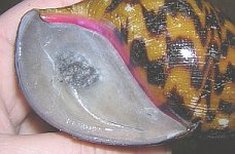Miscellaneous care information
Health checks
To ensure that GALS stay in good health it is important to perform a quick visual health check every day so that you can spot any signs of illness early on. When doing this you should look for the
following things:
Are they alert and active?
Is their skin moist and free from scratches, injuries and parasites?
Are they eating well?
Are their shells in good condition? They should be free from cracks, scratches and parasites. They should be dry and firm, with no areas of discolouration or crumbling. The entrance to the shell should be smooth and clean with no cracks, chips or excessive mucous.
If you find anything that gives you cause for concern, please take your pet to an exotics vet as soon as possible.
following things:
Are they alert and active?
Is their skin moist and free from scratches, injuries and parasites?
Are they eating well?
Are their shells in good condition? They should be free from cracks, scratches and parasites. They should be dry and firm, with no areas of discolouration or crumbling. The entrance to the shell should be smooth and clean with no cracks, chips or excessive mucous.
If you find anything that gives you cause for concern, please take your pet to an exotics vet as soon as possible.
Transportation

If you need to transport your GALS, you can use a small plastic tank designed for carrying small animals. Line the base of the tank with a layer of top soil and put in cucumber chunks to maintain hydration. Ensure that the lid is on securely and always carry the tank by the base, rather than the handle on the lid. Do not put the tank in direct sunlight, as they could over heat quickly.
Aestivation

If the environment is too cold or too dry, or food is in short supply, GALS may go into aestivation - a process similar to hibernation. GALS will withdraw into their shell and form a layer of mucous across the entrance. This layer dries to form a solid, silvery barrier between the snail and the outside world, keeping moisture inside to prevent dehydrate. It has been reported that GALS can stay in a state of aestivation for up to several years at a time. However, in captivity there should be no need for your GALS to aestivate. If aestivation occurs, there may be husbandry factors that require carefully addressing in order to meet your GALS needs.
Where a snail has gone into aestivation, you must not remove their protective layer, as you could easily damage his shell. Instead, check the tank is at a warm room temperature, spray the tank with warm water and provide fresh food, then leave him for a few hours to wake up at his own pace. If after several hours that has not woken him, you can put him in a very shallow bath of warm water and run a little warm water over his shell. This will wake him more quickly.
GALS should not be left in aestivation. Extensive research in captive hibernating reptiles has shown that animals in a state of dormancy need to be closely monitored in precise environmental conditions, to ensure that they do not lose body fat and condition too quickly. We also know that dormant animals who have food within their digestive tract can become very ill as the food decomposes.
Where a snail has gone into aestivation, you must not remove their protective layer, as you could easily damage his shell. Instead, check the tank is at a warm room temperature, spray the tank with warm water and provide fresh food, then leave him for a few hours to wake up at his own pace. If after several hours that has not woken him, you can put him in a very shallow bath of warm water and run a little warm water over his shell. This will wake him more quickly.
GALS should not be left in aestivation. Extensive research in captive hibernating reptiles has shown that animals in a state of dormancy need to be closely monitored in precise environmental conditions, to ensure that they do not lose body fat and condition too quickly. We also know that dormant animals who have food within their digestive tract can become very ill as the food decomposes.
